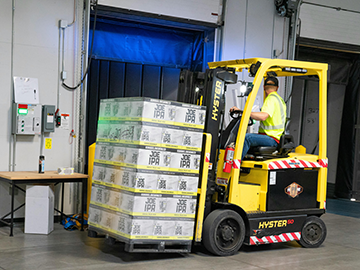Published: May 30, 2014 | Updated: September 16, 2025
Published: May 30, 2014 | Updated: September 16, 2025
Inventory Software for Small Businesses: Essential Asset Management & Cost Reduction
 For businesses responsible for maintaining equipment or facilities, the topic of inventory software arises frequently. While often associated with large corporations, a computerized maintenance management system (CMMS) offers substantial benefits to businesses of any size. The impact extends beyond simply managing maintenance; it positively influences the entire business structure. Let's look at inventory software for small businesses and how this affects asset management and cost reduction.
For businesses responsible for maintaining equipment or facilities, the topic of inventory software arises frequently. While often associated with large corporations, a computerized maintenance management system (CMMS) offers substantial benefits to businesses of any size. The impact extends beyond simply managing maintenance; it positively influences the entire business structure. Let's look at inventory software for small businesses and how this affects asset management and cost reduction.
The Value Proposition for Small Businesses
A CMMS provides the same core advantages to small businesses as it does to larger enterprises. While the scale of operation may differ, the fundamental principles of efficient asset management and cost control remain consistent. The financial impact, though scaled, holds significant weight for smaller operations.
Core Functionality: Asset Management
Asset management stands as the cornerstone of effective maintenance programs. This encompasses a broad spectrum of activities, including:
- Asset Location Tracking: Particularly vital for equipment that moves between locations, ensuring accurate tracking of all assets. Furthermore, for stock that stays in one place, the CMMS can help you specify a location for each item.
- Spare Parts Management: Maintaining precise records of spare parts, preventing shortages or overstocking. Automatic tracking of quantities gives you better oversight and helps with purchasing.
- Documentation and Procedure Storage: Centralizing access to operating manuals, procedures, and technical documentation for each asset. You can also enlist the CMMS for establishing an issue/return policy.
- Warranty and Receipt Management: Securely storing warranty information and purchase receipts for swift access during breakdowns.
Without a comprehensive understanding of owned equipment, its location, and detailed specifications, establishing and adhering to a maintenance schedule becomes challenging. Inventory software addresses this by consolidating all pertinent information into a centralized, easily accessible system. No more relying on cluttered spreadsheets and risking increased human error.
Transitioning from Manual Systems
Replacing outdated methods such as spreadsheets or paper-based filing systems with a CMMS eliminates the time-consuming process of searching for critical information. When equipment malfunctions, you need immediate action. Easy access to the above inventory data and vendor contact information for further purchases helps to minimize downtime.
Asset Management
Of course, much of the inventory you keep goes towards regular maintenance of assets. But what about those asset records? The CMMS has a place for all of those. Each has a listing with as much relevant detail as you want. Location, costs, associated preventive maintenance (PM, and more.
Speaking of PMs, you can create your list, and assign them (and inventory) to the assets. Easily convert the PM into a work order. Read on for further information on this.
Extending Asset Lifespan Through Preventative Maintenance
Implementing a solid preventative maintenance schedule, facilitated by a CMMS, extends the operational lifespan of equipment. Regular maintenance reduces the likelihood of unexpected breakdowns and costly repairs.
Well-maintained equipment operates more efficiently, resulting in reduced energy consumption. Conversely, poorly maintained machines tend to consume excessive energy. By ensuring equipment operates smoothly, businesses can achieve significant savings on energy bills.
Discover how streamlined maintenance processes can elevate production. Learn more.
Asset Depreciation
The system can track the depreciation of assets over time, providing accurate valuations for financial reporting and tax purposes. Calculating the depreciation of assets, and having that data easily accessible, allows for better long-term planning.
Work Order Management and Accountability
Beyond asset tracking, a CMMS facilitates the issuance and tracking of work orders. It will keep a record of backlogged and completed work orders. This helps your accountability and documentation for when auditors and regulators visit. Detailed records of maintenance activities serve as proof of proper upkeep, which may be required by vendors during warranty claims.
Furthermore, work order data enables businesses to analyze maintenance trends, forecast staffing requirements, and develop accurate budget projections. Historical maintenance records provide insights into the expected lifespan of equipment, allowing for proactive planning of replacements or upgrades.
Inventory Control and Cost Reduction
Inventory software plays a pivotal role in preventing over-ordering of assets or spare parts. By providing real-time visibility into inventory levels, businesses can make informed purchasing decisions.
Review the section regarding energy usage. Sometimes, that expense doesn't show up until later. The impact of inventory software extends beyond direct cost savings. With the proper usage of a CMMS, you'll see better efficiency, improved reliability of assets, more organized inventory management, and better decision-making with CMMS-generated reports.
 Detailed Inventory Management
Detailed Inventory Management
As mentioned, inventory management within a CMMS allows for detailed tracking of stock levels, movement, and valuation. This capability helps businesses that handle physical goods or maintain a stock of spare parts. The system can generate reports on inventory turnover, stock aging, and other key metrics, providing valuable insights into inventory performance.
One benefit of CMMS inventory management: Setting minimum quantity thresholds where when reached, the CMMS generates a purchase request. This keeps you more up-to-date on inventory control.
Tracking inventory movement provides a clear audit trail of all transactions, including receipts, shipments, and adjustments. This helps to identify discrepancies and prevent losses.
Accurate inventory valuation helps with financial reporting, purchasing, and budgeting. A CMMS can calculate inventory value using various methods, such as FIFO (first-in, first-out) or LIFO (last-in, first-out).
Integration with Other Systems
Many CMMS solutions offer integration with other business systems, such as accounting software or enterprise resource planning (ERP) systems. This integration enables seamless data exchange and eliminates the need for manual data entry, improving efficiency and accuracy. Of course, you'll need assistance from the CMMS provider, but once you have this integration, you'll see the benefits of transferred information.
Inventory Management Software: Keeping Your Stock Organized
By adopting inventory software, small businesses can enhance their asset management practices, reduce costs, and improve overall operational efficiency. The benefits extend beyond maintenance, impacting financial management, inventory control, and strategic planning.
Look for a CMMS that provides all of the above. Many areas overlap. Assets need maintenance which requires inventory that needs purchasing from vendors. You'll want a system that tracks the costs of everything and offers you substantial reports for better maintenance management.
FAQs
What is a CMMS and how can it help small businesses?
A CMMS is software that helps businesses manage assets, track maintenance, and control inventory, saving time and money.
How does CMMS inventory management reduce costs?
By tracking spare parts, preventing overstocking, and reducing downtime, CMMS lowers expenses.
Can MAPCON’s CMMS improve asset management?
Yes, MAPCON’s CMMS tracks asset location, depreciation, warranties, and maintenance history, making management easier.
How does preventive maintenance in a CMMS extend equipment life?
It schedules regular upkeep, reducing breakdowns and helping equipment last longer.
Why switch from spreadsheets to a CMMS for inventory tracking?
A CMMS centralizes data, reduces errors, and gives instant access to critical information.
Does CMMS software integrate with other business systems?
Yes, many CMMS solutions, including MAPCON, integrate with ERP and accounting systems for smoother operations.
MAPCON | 800-922-4336
MAPCON CMMS software empowers you to plan and execute PM tasks flawlessly, thanks to its wealth of features and customizable options. Want to see it for yourself? Click the button below to get your FREE 30-day trial of MAPCON!
Try It FREE!